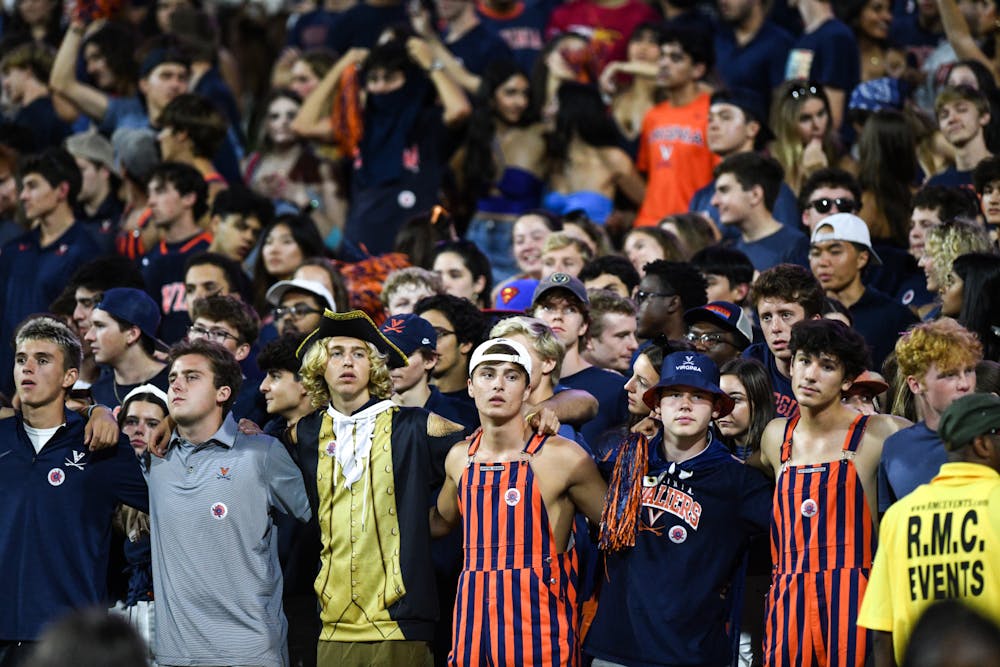Virginia football’s battle with Maryland last week seemed like it would have packed out Scott Stadium. It was the 80th installment of a rivalry that dates back over 100 years and the first time since 2012 that the Terrapins were playing in Charlottesville. The Cavaliers were 2-0, coming off a road win over Wake Forest in their ACC opener and searching for the program’s first 3-0 start since 2019. It was also a Saturday night game with a national broadcast on ACC Network.
And yet, the atmosphere in Scott Stadium fell flat. The Hill never filled up and, as per usual, the upper level did not get close to full capacity. The official attendance was reported as 41,352, a measly 67.2 percent of the 61,500-seat venue.
People took note, too. Former Virginia running back Mikell Simpson — who played in multiple home games that eclipsed 60,000 in attendance in the late 2000s — shared his disappointment in the fan turnout in a post on X that received over 60,000 views. Simpson noted that the Cavaliers, who were undefeated heading into last Saturday’s game, deserved more support from their fans.
While Simpson’s disappointment is understandable, I think the program’s persistent attendance problem goes much deeper than winning in the short-term. Virginia hasn’t put together a period of prolonged success in almost 20 years, and as those years have gone by, the memories of a Cavalier team worth watching have gotten farther and farther away.
Twelve years ago, when Virginia last hosted Maryland, the Cavaliers were 2-4 entering the game. They were on a four-game losing streak, three of which had come by 20 or more points. But even for that game, the 45,556 fans in attendance cleared the mark from last week.
The time before that? November 2010, when Virginia’s season was effectively over with the team sitting at 1-4 in the ACC and 4-5 overall. Still, the announced attendance was 45,634 — also more than Saturday’s game.
By far, the Cavaliers had more on the line last week than in either of their previous two home matchups with the Terrapins. Coach Tony Elliott even implored the fans to “pack the stadium” in the leadup to the contest, and after the spring game in April, he requested record attendance during the 2024 season.
Why, then, is that not remotely close to happening? Why was Virginia’s promising 2-0 start, electrifying young quarterback and renewed rivalry with Maryland not good enough? I think Cavalier fans have fallen out of touch with their football team.
The string of losing seasons in the 2010s took a substantial toll on the fanbase. That toll got bigger when, in the midst of those losing seasons, the team also lost its identity. Gone were the days of Al Groh’s gritty, defensive-minded Virginia squads. Even longer gone were the days of George Welsh, the legendary Cavalier coach who brought the program back to relevance and reignited the rivalry with Virginia Tech before retiring at the turn of the century.
Fans stuck around in decent numbers during the start of Mike London’s tenure, but by 2014 — the team’s third of six consecutive losing seasons — the two sides started to pull apart. Virginia could no longer rest upon its past laurels, as the once proud program was slowly being stripped of its character.
Between 2014 and 2018, average attendance failed to clear 40,000 four out of five times, the last three of which came under Bronco Mendenhall’s tutelage. After the Cavaliers produced a nine-win season and a trip to the ACC Championship in 2019, that number ticked up to 47,863 — still well short of anything significant. Virginia had a good team, but it was just one good team — no tradition of winning came from it, nothing for the fanbase to truly rally behind.
Since then, it has been a five-year period of mediocrity. No bowl game appearances, no winning seasons and perpetual embarrassment against Virginia Tech and James Madison. The Cavaliers are no closer to re-establishing their identity, and a pair of victories to open the season was never going to change that. It will require years of winning, years of being a serious football program before Virginia fans have any reason to come back in full force.
And I’ll tell you what certainly won’t bring them back — the improved “gameday experience” at Scott Stadium. If you’ve been to one of the Cavaliers’ two home games this year, you’ll have noticed the big scoreboard, the impressive light show and the pregame fireworks.
Add in the new $80 million football operations center, and Virginia is trying its hardest to act like a winning football program. But Cavalier fans can’t be bought, and until the product on the field is worth rooting for, no amount of pyrotechnics or surround-sound speakers will be enough to satisfy a fanbase that cares about one thing above all else.
Virginia has an attendance problem, and the solution is not in sight.







